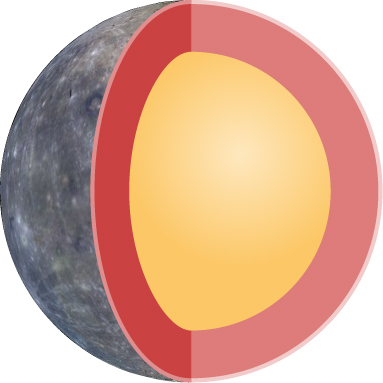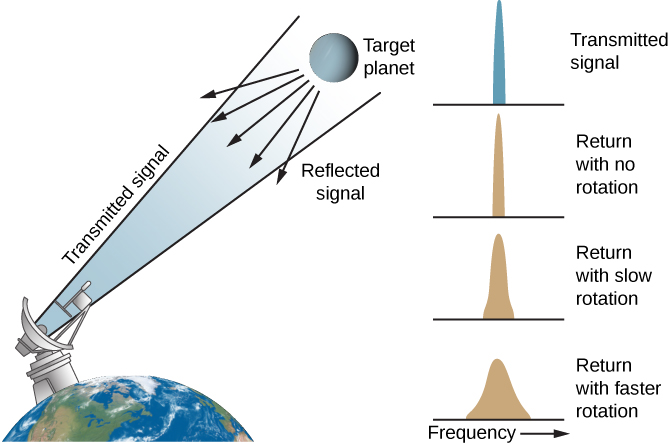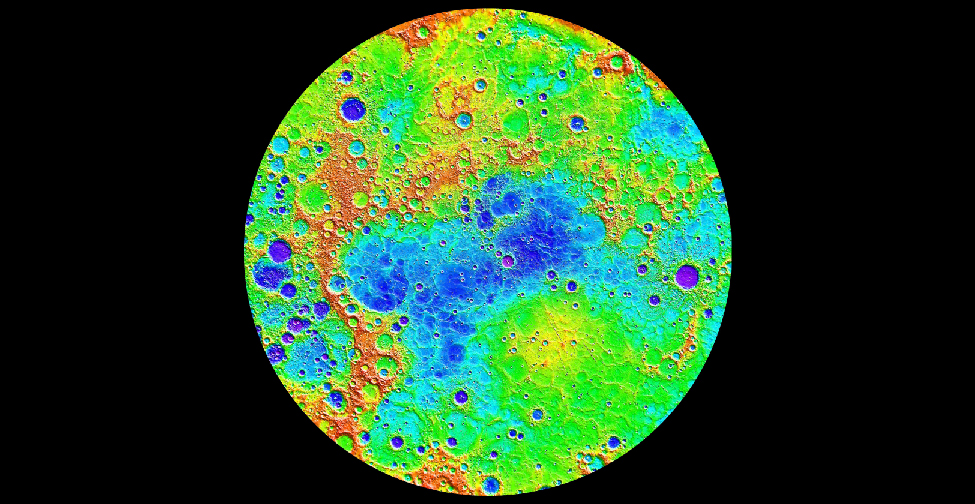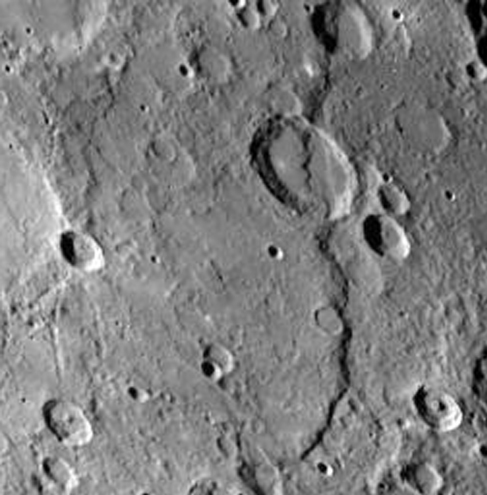
By the end of this section, you will be able to:
The planet Mercury is similar to the Moon in many ways. Like the Moon, it has no atmosphere, and its surface is heavily cratered. As described later in this chapter, it also shares with the Moon the likelihood of a violent birth.
Mercury is the nearest planet to the Sun, and, in accordance with Kepler’s third law, it has the shortest period of revolution about the Sun (88 of our days) and the highest average orbital speed (48 kilometers per second). It is appropriately named for the fleet-footed messenger god of the Romans. Because Mercury remains close to the Sun, it can be difficult to pick out in the sky. As you might expect, it’s best seen when its eccentric orbit takes it as far from the Sun as possible.
The semimajor axis of Mercury’s orbit—that is, the planet’s average distance from the Sun—is 58 million kilometers, or 0.39 AU. However, because its orbit has the high eccentricity of 0.206, Mercury’s actual distance from the Sun varies from 46 million kilometers at perihelion to 70 million kilometers at aphelion (the ideas and terms that describe orbits were introduced in Orbits and Gravity).
Mercury’s mass is one-eighteenth that of Earth, making it the smallest terrestrial planet. Mercury is the smallest planet (except for the dwarf planets), having a diameter of 4878 kilometers, less than half that of Earth. Mercury’s density is 5.4 g/cm3, much greater than the density of the Moon, indicating that the composition of those two objects differs substantially.
Mercury’s composition is one of the most interesting things about it and makes it unique among the planets. Mercury’s high density tells us that it must be composed largely of heavier materials such as metals. The most likely models for Mercury’s interior suggest a metallic iron-nickel core amounting to 60% of the total mass, with the rest of the planet made up primarily of silicates. The core has a diameter of 3500 kilometers and extends out to within 700 kilometers of the surface. We could think of Mercury as a metal ball the size of the Moon surrounded by a rocky crust 700 kilometers thick ([link]). Unlike the Moon, Mercury does have a weak magnetic field. The existence of this field is consistent with the presence of a large metal core, and it suggests that at least part of the core must be liquid in order to generate the observed magnetic field.1

Densities of Worlds The average density of a body equals its mass divided by its volume. For a sphere, density is:
Astronomers can measure both mass and radius accurately when a spacecraft flies by a body.
Using the information in this chapter, we can calculate the approximate average density of the Moon.
Solution For a sphere,
[link] gives a value of 3.3 g/cm3, which is 3.3 × 103 kg/m3.
Check Your Learning Using the information in this chapter, calculate the average density of Mercury. Show your work. Does your calculation agree with the figure we give in this chapter?
That matches the value given in [link] when g/cm3 is converted into kg/m3.
Visual studies of Mercury’s indistinct surface markings were once thought to indicate that the planet kept one face to the Sun (as the Moon does to Earth). Thus, for many years, it was widely believed that Mercury’s rotation period was equal to its revolution period of 88 days, making one side perpetually hot while the other was always cold.
Radar observations of Mercury in the mid-1960s, however, showed conclusively that Mercury does not keep one side fixed toward the Sun. If a planet is turning, one side seems to be approaching Earth while the other is moving away from it. The resulting Doppler shift spreads or broadens the precise transmitted radar-wave frequency into a range of frequencies in the reflected signal ([link]). The degree of broadening provides an exact measurement of the rotation rate of the planet.

Mercury’s period of rotation (how long it takes to turn with respect to the distant stars) is 59 days, which is just two-thirds of the planet’s period of revolution. Subsequently, astronomers found that a situation where the spin and the orbit of a planet (its year) are in a 2:3 ratio turns out to be stable. (See [link] for more on the effects of having such a long day on Mercury.)
Mercury, being close to the Sun, is very hot on its daylight side; but because it has no appreciable atmosphere, it gets surprisingly cold during the long nights. The temperature on the surface climbs to 700 K (430 °C) at noontime. After sunset, however, the temperature drops, reaching 100 K (–170 °C) just before dawn. (It is even colder in craters near the poles that receive no sunlight at all.) The range in temperature on Mercury is thus 600 K (or 600 °C), a greater difference than on any other planet.
Mercury rotates three times for each two orbits around the Sun. It is the only planet that exhibits this relationship between its spin and its orbit, and there are some interesting consequences for any observers who might someday be stationed on the surface of Mercury.
Here on Earth, we take for granted that days are much shorter than years. Therefore, the two astronomical ways of defining the local “day”—how long the planet takes to rotate and how long the Sun takes to return to the same position in the sky—are the same on Earth for most practical purposes. But this is not the case on Mercury. While Mercury rotates (spins once) in 59 Earth days, the time for the Sun to return to the same place in Mercury’s sky turns out to be two Mercury years, or 176 Earth days. (Note that this result is not intuitively obvious, so don’t be upset if you didn’t come up with it.) Thus, if one day at noon a Mercury explorer suggests to her companion that they should meet at noon the next day, this could mean a very long time apart!
To make things even more interesting, recall that Mercury has an eccentric orbit, meaning that its distance from the Sun varies significantly during each mercurian year. By Kepler’s law, the planet moves fastest in its orbit when closest to the Sun. Let’s examine how this affects the way we would see the Sun in the sky during one 176-Earth-day cycle. We’ll look at the situation as if we were standing on the surface of Mercury in the center of a giant basin that astronomers call Caloris ([link]).
At the location of Caloris, Mercury is most distant from the Sun at sunrise; this means the rising Sun looks smaller in the sky (although still more than twice the size it appears from Earth). As the Sun rises higher and higher, it looks bigger and bigger; Mercury is now getting closer to the Sun in its eccentric orbit. At the same time, the apparent motion of the Sun slows down as Mercury’s faster motion in orbit begins to catch up with its rotation.
At noon, the Sun is now three times larger than it looks from Earth and hangs almost motionless in the sky. As the afternoon wears on, the Sun appears smaller and smaller, and moves faster and faster in the sky. At sunset, a full Mercury year (or 88 Earth days after sunrise), the Sun is back to its smallest apparent size as it dips out of sight. Then it takes another Mercury year before the Sun rises again. (By the way, sunrises and sunsets are much more sudden on Mercury, since there is no atmosphere to bend or scatter the rays of sunlight.)
Astronomers call locations like the Caloris Basin the “hot longitudes” on Mercury because the Sun is closest to the planet at noon, just when it is lingering overhead for many Earth days. This makes these areas the hottest places on Mercury.
We bring all this up not because the exact details of this scenario are so important but to illustrate how many of the things we take for granted on Earth are not the same on other worlds. As we’ve mentioned before, one of the best things about taking an astronomy class should be ridding you forever of any “Earth chauvinism” you might have. The way things are on our planet is just one of the many ways nature can arrange reality.
The first close-up look at Mercury came in 1974, when the US spacecraft Mariner 10 passed 9500 kilometers from the surface of the planet and transmitted more than 2000 photographs to Earth, revealing details with a resolution down to 150 meters. Subsequently, the planet was mapped in great detail by the MESSENGER spacecraft, which was launched in 2004 and made multiple flybys of Earth, Venus, and Mercury before settling into orbit around Mercury in 2011. It ended its life in 2015, when it was commanded to crash into the surface of the planet.
Mercury’s surface strongly resembles the Moon in appearance ([link] and [link]). It is covered with thousands of craters and larger basins up to 1300 kilometers in diameter. Some of the brighter craters are rayed, like Tycho and Copernicus on the Moon, and many have central peaks. There are also scarps (cliffs) more than a kilometer high and hundreds of kilometers long, as well as ridges and plains.
MESSENGER instruments measured the surface composition and mapped past volcanic activity. One of its most important discoveries was the verification of water ice (first detected by radar) in craters near the poles, similar to the situation on the Moon, and the unexpected discovery of organic (carbon-rich) compounds mixed with the water ice.
Scientists working with data from the MESSENGER mission put together a rotating globe of Mercury, in false color, showing some of the variations in the composition of the planet’s surface. You can watch it spin.

![This partially flooded impact basin is the largest known structural feature on Mercury. The smooth plains in the interior of the basin have an area of almost two million square kilometers. Compare this photo with [link], the Orientale Basin on the Moon. (credit: NASA/Johns Hopkins University Applied Physics Laboratory/Carnegie Institution of Washington) Photograph of the Caloris Basin on Mercury. The circular, flat plain of Caloris Basin is surrounded by cratered highlands and rough terrain. A few impact craters are scattered over the smooth surface of the basin.](../resources/OSC_Astro_09_05_Basin.jpg)
Most of the mercurian features have been named in honor of artists, writers, composers, and other contributors to the arts and humanities, in contrast with the scientists commemorated on the Moon. Among the named craters are Bach, Shakespeare, Tolstoy, Van Gogh, and Scott Joplin.
There is no evidence of plate tectonics on Mercury. However, the planet’s distinctive long scarps can sometimes be seen cutting across craters; this means the scarps must have formed later than the craters ([link]). These long, curved cliffs appear to have their origin in the slight compression of Mercury’s crust. Apparently, at some point in its history, the planet shrank, wrinkling the crust, and it must have done so after most of the craters on its surface had already formed.
If the standard cratering chronology applies to Mercury, this shrinkage must have taken place during the last 4 billion years and not during the solar system’s early period of heavy bombardment.

The problem with understanding how Mercury formed is the reverse of the problem posed by the composition of the Moon. We have seen that, unlike the Moon, Mercury is composed mostly of metal. However, astronomers think that Mercury should have formed with roughly the same ratio of metal to silicate as that found on Earth or Venus. How did it lose so much of its rocky material?
The most probable explanation for Mercury’s silicate loss may be similar to the explanation for the Moon’s lack of a metal core. Mercury is likely to have experienced several giant impacts very early in its youth, and one or more of these may have torn away a fraction of its mantle and crust, leaving a body dominated by its iron core.
You can follow some of NASA’s latest research on Mercury and see some helpful animations on the MESSENGER web page.
Today, astronomers recognize that the early solar system was a chaotic place, with the final stages of planet formation characterized by impacts of great violence. Some objects of planetary mass have been destroyed, whereas others could have fragmented and then re-formed, perhaps more than once. Both the Moon and Mercury, with their strange compositions, bear testimony to the catastrophes that must have characterized the solar system during its youth.
Mercury is the nearest planet to the Sun and the fastest moving. Mercury is similar to the Moon in having a heavily cratered surface and no atmosphere, but it differs in having a very large metal core. Early in its evolution, it apparently lost part of its silicate mantle, probably due to one or more giant impacts. Long scarps on its surface testify to a global compression of Mercury’s crust during the past 4 billion years.
Bakich, Michael. “Asia’s New Assault on the Moon.” Astronomy (August 2009): 50. The Japanese Selene and Chinese Chang’e 1 missions.
Beatty, J. “NASA Slams the Moon.” Sky & Telescope (February 2010): 28. The impact of the LCROSS mission on the Moon and what we learned from it.
Bell, T. “Warning: Dust Ahead.” Astronomy (March 2006): 46. What we know about lunar dust and the problems it can cause.
Dorminey, B. “Secrets beneath the Moon’s Surface.” Astronomy (March 2011): 24. A nice timeline of the Moon’s evolution and the story of how we are finding out more about its internal structure.
Jayawardhana, R. “Deconstructing the Moon.” Astronomy (September 1998): 40. An update on the giant impact hypothesis for forming the Moon.
Register, B. “The Fate of the Moon Rocks.” Astronomy (December 1985): 15. What was done with the rocks the astronauts brought back from the Moon.
Schmitt, H. “Exploring Taurus–Littrow: Apollo 17.” National Geographic (September 1973). First-person account given by the only scientist to walk on the Moon.
Schmitt, H. “From the Moon to Mars.” Scientific American (July 2009): 36. The only scientist to walk on the Moon reflects on the science from Apollo and future missions to Mars.
Schultz, P. “New Clues to the Moon’s Distant Past.” Astronomy (December 2011): 34. Summary of results and ideas from the LCROSS and LRO missions.
Shirao, M. “Kayuga’s High Def Highlights.” Sky & Telescope (February 2010): 20. Results from the Japanese mission to the Moon, with high definition TV cameras.
Wadhwa, M. “What Are We Learning from the Moon Rocks?” Astronomy (June 2013): 54. Very nice discussion of how the rocks tell us about Moon’s composition, age, and origin.
Wood, Charles. “The Moon’s Far Side: Nearly a New World.” Sky & Telescope (January 2007): 48. This article compares what we know about the two sides and why they are different.
Zimmerman, R. “How Much Water is on the Moon?” Astronomy (January 2014): 50. Results from the LRO’s instruments and good overview of issue.
Beatty, J. “Mercury Gets a Second Look.” Sky & Telescope (March 2009): 26. The October 2008 MESSENGER mission flyby.
Beatty, J. “Reunion with Mercury.” Sky & Telescope (May 2008): 24. The January 2008 MESSENGER encounter with Mercury.
“Mercury: Meet the Planet Nearest the Sun.” Sky & Telescope (March 2014): 39. Four-page pictorial introduction, including the new MESSENGER probe full map of the planet provided.
Oberg, J. “Torrid Mercury’s Icy Poles.” Astronomy (December 2013): 30. A nice overview of results from MESSENGER mission, including the ice in polar craters.
Sheehan, W., and Dobbins, T. “Mesmerized by Mercury.” Sky & Telescope (June 2000): 109. History of Mercury observations and how amateur astronomers can contribute.
Talcott, R. “Surprises from MESSENGER’s Historic Mercury Fly-by.” Astronomy (March 2009): 28.
Talcott, R. “Mercury Reveals its Hidden Side.” Astronomy (May 2008): 26. Results and image from the MESSENGER mission flyby of January 2008.
Apollo Lunar Surface Journal: http://www.hq.nasa.gov/office/pao/History/alsj/. Information, interviews, maps, photos, video and audio clips, and much more on each of the Apollo landing missions.
Lunar & Planetary Institute: http://www.lpi.usra.edu/lunar/missions/. Lunar Science and Exploration web pages.
Lunar Reconnaissance Orbiter Mission Page: http://lro.gsfc.nasa.gov/.
NASA’s Guide to Moon Missions and Information: http://nssdc.gsfc.nasa.gov/planetary/planets/moonpage.html.
Origin of the Moon: http://www.psi.edu/projects/moon/moon.html. By William Hartmann, who, with a colleague, first suggested the giant impact hypothesis for how the Moon formed, in 1975.
Sky & Telescope magazine’s observing guides and articles about the Moon: http://www.skyandtelescope.com/observing/celestial-objects-to-watch/moon/.
To the Moon: http://www.pbs.org/wgbh/nova/tothemoon/. PBS program on the Apollo landings.
We Choose the Moon: http://wechoosethemoon.org/. A recreation of the Apollo 11 mission.
Mercury Unveiled by G. Jeffrey Taylor (summarizing the Mariner 10 Mission): http://www.psrd.hawaii.edu/Jan97/MercuryUnveiled.html.
MESSENGER Mission Website: http://messenger.jhuapl.edu/.
NASA Planetary Data Center Mercury Page: http://nssdc.gsfc.nasa.gov/planetary/planets/mercurypage.html.
Views of the Solar System Mercury Page: http://solarviews.com/eng/mercury.htm.
target=MERCURY&featureType=Crater,%20craters). Living persons are not eligible. Can each person in your group think of a scientist or someone in the arts whom they especially respect? Now check to see if they are listed. Are there scientists or people in the arts who should have their names on the Moon or Mercury and do not?
What is the composition of the Moon, and how does it compare to the composition of Earth? Of Mercury?
Why does the Moon not have an atmosphere?
What are the principal features of the Moon observable with the unaided eye?
Frozen water exists on the lunar surface primarily in which location? Why?
Outline the main events in the Moon’s geological history.
What are the maria composed of? Is this material found elsewhere in the solar system?
The mountains on the Moon were formed by what process?
With no wind or water erosion of rocks, what is the mechanism for the creation of the lunar “soil?”
What differences did Grove K. Gilbert note between volcanic craters on Earth and lunar craters?
Explain how high-speed impacts form circular craters. How can this explanation account for the various characteristic features of impact craters?
Explain the evidence for a period of heavy bombardment on the Moon about 4 billion years ago.
How did our exploration of the Moon differ from that of Mercury (and the other planets)?
Summarize the four main hypotheses for the origin of the Moon.
What are the difficulties with the capture hypothesis of the Moon’s origin?
What is the main consequence of Mercury’s orbit being so highly eccentric?
Describe the basic internal structure of Mercury.
How was the rotation rate of Mercury determined?
What is the relationship between Mercury’s rotational period and orbital period?
The features of Mercury are named in honor of famous people in which fields of endeavor?
What do our current ideas about the origins of the Moon and Mercury have in common? How do they differ?
One of the primary scientific objectives of the Apollo program was the return of lunar material. Why was this so important? What can be learned from samples? Are they still of value now?
Apollo astronaut David Scott dropped a hammer and a feather together on the Moon, and both reached the ground at the same time. What are the two distinct advantages that this experiment on the Moon had over the same kind of experiment as performed by Galileo on Earth?
Galileo thought the lunar maria might be seas of water. If you had no better telescope than the one he had, could you demonstrate that they are not composed of water?
Why did it take so long for geologists to recognize that the lunar craters had an impact origin rather than a volcanic one?
How might a crater made by the impact of a comet with the Moon differ from a crater made by the impact of an asteroid?
Why are the lunar mountains smoothly rounded rather than having sharp, pointed peaks (as they were almost always depicted in science-fiction illustrations and films before the first lunar landings)?
The lunar highlands have about ten times more craters in a given area than do the maria. Does this mean that the highlands are 10 times older? Explain your reasoning.
At the end of the section on the lunar surface, your authors say that lunar night and day each last about two Earth weeks. After looking over the information in Earth, Moon, and Sky and this chapter about the motions of the Moon, can you explain why? (It helps to draw a diagram for yourself.)
Give several reasons Mercury would be a particularly unpleasant place to build an astronomical observatory.
If, in the remote future, we establish a base on Mercury, keeping track of time will be a challenge. Discuss how to define a year on Mercury, and the two ways to define a day. Can you come up with ways that humans raised on Earth might deal with time cycles on Mercury?
The Moon has too little iron, Mercury too much. How can both of these anomalies be the result of giant impacts? Explain how the same process can yield such apparently contradictory results.
In the future, astronomers discover a solid moon around a planet orbiting one of the nearest stars. This moon has a diameter of 1948 km and a mass of 1.6 × 1022 kg. What is its density?
The Moon was once closer to Earth than it is now. When it was at half its present distance, how long was its period of revolution? (See Orbits and Gravity for the formula to use.)
Astronomers believe that the deposit of lava in the giant mare basins did not happen in one flow but in many different eruptions spanning some time. Indeed, in any one mare, we find a variety of rock ages, typically spanning about 100 million years. The individual lava flows as seen in Hadley Rille by the Apollo 15 astronauts were about 4 m thick. Estimate the average time interval between the beginnings of successive lava flows if the total depth of the lava in the mare is 2 km.
The Moon requires about 1 month (0.08 year) to orbit Earth. Its distance from us is about 400,000 km (0.0027 AU). Use Kepler’s third law, as modified by Newton, to calculate the mass of Earth relative to the Sun.

You can also download for free at http://cnx.org/contents/2e737be8-ea65-48c3-aa0a-9f35b4c6a966@14.4
Attribution: